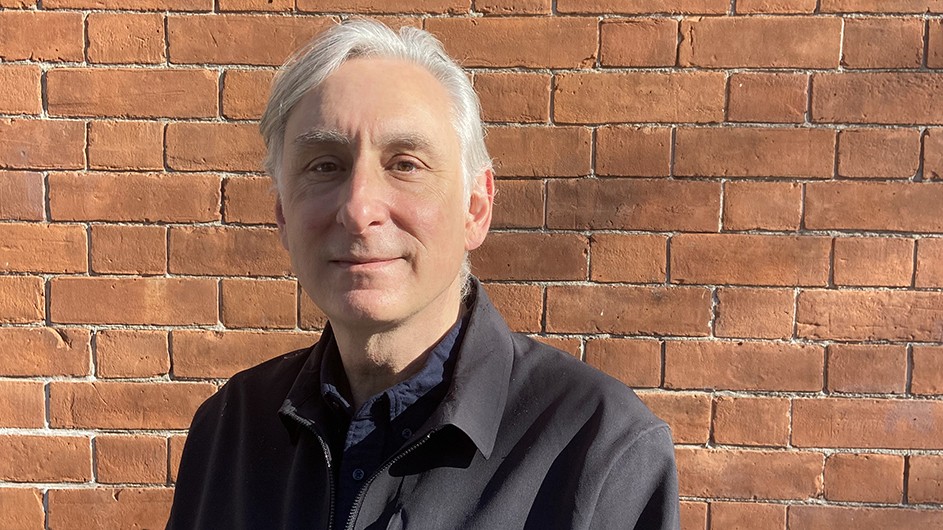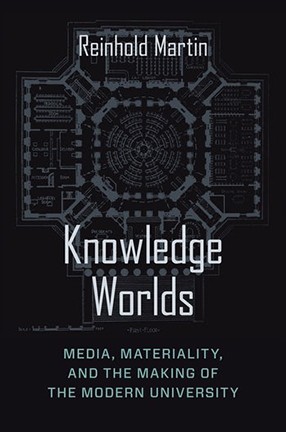How Do We Learn What We Know?
In his new book, Professor Reinhold Martin reveals how universities have created and controlled knowledge for the past two centuries.

What do the practices and systems that have shaped institutions of higher learning in the United States—from the Ivy League and women’s colleges to historically black colleges and land-grant universities—teach us about the production and distribution of knowledge? Addressing media theory, architectural history, and the history of academia, Knowledge Worlds: Media, Materiality, and the Making of the Modern University, by Professor Reinhold Martin, who teaches at the Graduate School of Architecture, Planning, and Preservation, reconceives the university as a media complex through which knowledge is made, conveyed, and withheld.
Martin argues that the material infrastructures of the modern university—the architecture of academic buildings, the configuration of seminar tables, the organization of campus plans—reveal the ways in which knowledge is created and reproduced in different kinds of institutions.
He reconstructs changes in aesthetic strategies, pedagogical techniques, and political economy to show how the boundaries that govern higher education have shifted over the past two centuries. From colleges chartered as rights-bearing corporations to research universities conceived as knowledge factories, educating some has always depended upon excluding others.
Martin discusses the book with Columbia News, as well as what he’s been reading lately, what he plans to read next, and how he and his students have helped each other cope with the pandemic.
Q. How did you come up with the idea for this book?
A. Knowledge Worlds is a history of universities written, so to speak, from the basement of Philosophy Hall, where the campus computer store used to be. That is, it’s a history of the media of which universities are made. It’s also a history of the power our institutions reproduce, less in the raw imperial sense of a long-gone “American century” than as gatekeeping. Most of all though, the book is a love letter to libraries. Among the media it considers is the moonlike lighting fixture—Enlightenment at dusk—that once hung from the Low Library dome, while readers like B. R. Ambedkar, a world-historical student of John Dewey, sat below.
I also wrote the book to show how the future of universities depends on their past. Like Low Library, all university buildings are haunted, even when they’re brand new. That’s partly because our institutions are corporations and therefore potentially immortal; but it’s also because they’re never born or founded just once. They are constantly refounded, their knowledge infrastructures re-engineered. It’s we, the constituents and caretakers of these institutions, who do the refounding and re-engineering alongside those who lay the cornerstones. Knowledge Worlds was completed during a time of great peril for universities, the knowledge they produce, and the sanctuary they offer, so it’s the kind of critique that values its object too highly to do otherwise.

Q. Can you give some examples from the book of the different ways in which knowledge is created and disseminated at universities?
A. Since I decided not to include a chapter on college sports and stadiums, the book doesn’t have much to say about the Ivy League, though that league’s members are included. But sports are a good place to begin; they are all about schedules, and schedules are infrastructural insofar as they repeat, like classes or laboratory experiments. The only sporting figure that appears in the book is the Bryn Mawr Owl, guarding a campus gate. As a history of media, the book argues that the most important thing about the owl is that it was hand carved in neo-Gothic stone and not stamped in industrial brick, as it might have been at Vassar, or more tellingly, at the historically Black Tuskegee Institute, where students built the buildings.
Defining media as intermediary things, Knowledge Worlds thinks of colleges and universities as provisional solutions to boundary problems. Seen this way, universities are instruments for maintaining the silence and the freedom necessary for certain people to read, write, and speak at certain times and in certain places. Reproducing different hierarchies, each media complex, or network of mediating infrastructures, organizes these relations differently.
For example, many early land-grant universities like Arizona or Wisconsin included agricultural research stations and other off-campus sites through which technical knowledge circulated in pamphlets and reports. This type of pre-philosophical “traveling theory,” to borrow from Edward Said, helped to shape an agricultural orientalism based on the exchange of plant species with colonized ecologies. Elsewhere and earlier, students in the ecclesiastical colleges spent countless hours reciting classical verse to secure what the famous Yale Report called the “discipline and furniture of the mind.” This contrasted with another kind of classical learning: the visual study of Euclidean geometry by engineers at polytechnics. These two competing classicisms divided knowledge and labor by medium, along lines of class, gender, and race that my own field, architecture, reinforced.
Architecture is both infrastructural and symbolic. At Columbia, I’ve been fortunate to learn a great deal about opening doors between schools and departments from inspired colleagues in centers and institutes across the humanities and the social sciences, including the Center for Comparative Media, the Institute for Comparative Literature and Society, the Committee on Global Thought, and the Society of Fellows / Heyman Center for the Humanities. But Knowledge Worlds also shows how an interdisciplinary architecture can compromise autonomy, as in the case of some on-campus think tanks. Stanford’s scientific “steeples of excellence,” for example, symbolically meet Silicon Valley’s neoliberal, entrepreneurial “spirit” in the Hoover Institution’s iconic, crypto-theological tower.
Q. Can you discuss your work at the Buell Center for the Study of American Architecture, and how it relates to your research?
A. The period during which I’ve researched and written Knowledge Worlds coincides roughly with my time as director of the Buell Center. There, we try to think about how architecture puts “America” in the world, as the book also does.
For example, with the foreclosure of the “American Dream” by the 2008 financial crisis, we responded with an effort to reimagine public housing. More recently, we’ve been thinking about climate change at the intersection of infrastructure and society. Much of the Buell Center’s current work is documented on a website, Power: Infrastructure in America, which reflects partnerships and collaborations with numerous individuals and institutions. Topics range from racialized emergency management in Flint, Michigan, to the infrastructural implications of the Green New Deal, with teams of student researchers regularly contributing material. Most recent is The A&E System, a downloadable report on the large, and largely anonymous, architecture and engineering firms that build “green” infrastructure and often control its management through public-private partnerships, which should worry anyone concerned with democratic access to public goods like water.
Q. What books do you recommend for getting through the pandemic?
A. To be honest, this long, sad winter has left less time for leisurely reading than I had hoped. Like so many, I’ve spent a good deal of whatever free time there’s been reading and watching news accounts of our intertwined set of national and global tragedies. In that sense, “long” may be a euphemistic placeholder for adjectives we haven’t yet found to describe the past year and its dire seasons. In a world where reading or rereading a book can sometimes mean watching its adaptation on television, I admit especially missing the pandemic-interrupted Handmaid’s Tale. In an odd, intermedial feedback loop, Margaret Atwood seems to have been prompted by the TV series to write a sequel, The Testaments, which I read during the pandemic’s early days. Notably, the original book and the series locate the origins of Gilead in an armed assault by holy warriors on the U.S. Capitol.
Q. Any others on your reading list?
A. Among other things, to better understand where we’ve been and where we may yet be going, I’m planning next to reread Ayn Rand’s Fountainhead—which grotesquely exalts the white, masculine master-builder as a cultish figure of individual “liberty.” I’ll have to brace myself for that one.
Q. What's the last great book you read?
A. Well, since you put it that way, I’d have to say Mortimer Adler’s The Great Ideas: A Syntopicon, Volumes 1 and 2. These are not really books, but an index to the 54-volume Great Books of the Western World, which Adler coedited with University of Chicago president Robert Hutchins in 1952. A syntopicon is something you consult in order to learn about the 102 “great ideas” that the Great Books contain, from “Angel” to “World,” without having to read the books themselves. Hutchins saw these ideas as the basis of a “great conversation” across the ages. In my own book, I argue that this overconfident “Western canon” is less a humanistic bulwark against mass culture than it is a mass cultural product: a standardized list, that—by the way—was worked out in large measure around seminar tables at Columbia. Maybe I should write a syntopicon for Knowledge Worlds.
Q. Do you read actual books or do you use an e-reader?
A. Both. The problem is the different reading glasses I need for each.
Q. What are you teaching this term? How are you helping your students cope with online learning?
Q. I’m teaching a new course, “Climate, Technology, and Society,” which is an introduction to critical thought on climate change. The students are amazing; it’s more like we help each other get through this by maintaining a nearly unstoppable “great conversation” to look forward to each week. It’s a pilot, intended ultimately as a GSAPP-wide class and beyond. But I haven’t yet figured out whether it’s really for everybody, or just for those who are ready to grapple with the social contradictions of a carbon-based economy, and of many “green” technologies as well.
Q. You're hosting a dinner party. Which three academics or scholars, dead or alive, would you invite and why?
A. A slight twist: A sunny day in Morningside Heights—Theodor Adorno, Hannah Arendt, and John Dewey cross paths at the corner of 112th Street and Broadway, and decide to have lunch at Tom’s Restaurant, downstairs from where Dewey once lived—Seinfeld for scholars. What would they discuss? Would Adorno walk out? What did Arendt and Dewey really think of one another? W. E. B. Du Bois walks by, visiting friends. Do they notice? Though Adorno only passed through the neighborhood briefly, Arendt and Dewey overlapped for a decade. Tom’s has been around since the 1940s. So it’s just about conceivable. Like campuses, college towns and neighborhoods are haunted. Think of all the dinner parties in all these apartments over all these years. Mortimer Adler and Robert Hutchins spoke wistfully of a “great conversation” among a select few. I’d prefer to think instead about a great, boisterous comedy, more Aristophanes than Aristotle, met by laughter from outside the walls.
Check out Books to learn more about publications by Columbia professors.